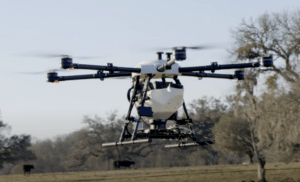NAAA Says Drones Won’t Replace Airplanes: DRONELIFE Exclusive Interview
 Despite their growing presence, drones complement rather than replace manned aircraft in agriculture due to speed and capacity advantages, says NAAA CEO Andrew Moore.
Despite their growing presence, drones complement rather than replace manned aircraft in agriculture due to speed and capacity advantages, says NAAA CEO Andrew Moore.
By DRONELIFE Features Editor Jim Magill
Despite the growth in the use of drones in agricultural applications, unmanned aerial vehicles likely will not displace the use of manned aircraft in the foreseeable future, the CEO of the National Agricultural Aviation Association said in an interview.
“What we’re seeing at this point is more of a complementary relationship,” said Andrew Moore. “I think you’re seeing uncrewed aircraft maybe doing stuff that ground rigs were doing, or they’re treating areas that normally wouldn’t have been done by crewed aircraft because they’re tougher to reach.”
The NAAA, which represents small businesses and pilots that use aircraft in agricultural applications, includes among its members drone operators in addition to the operators of the more traditional manned aviation aircraft, such as small planes and helicopters. “We, as an association, do advocate for them,” Moore said.
The number of drones used in agricultural applications in the U.S. has risen rapidly in the past several years. According to Federal Aviation Administration data, the FAA approved 837 applications to operate agricultural drones from June 2023 to today. This compares with 137 total approvals prior to June 2023.
“Current FAA rulemaking efforts are focused on developing a standard set of rules for operations beyond visual line-of-sight (BVLOS) to make these kinds of operations routine, scalable and economically viable,” according to an FAA statement.
However, despite the growth in the use of ag drones, Moore said two factors – speed and product carrying capacity — tend to favor the continued dominance in the use of manned aircraft to aid farmers in producing food, fiber and bioenergy, and in protecting forestry and controlling health-threatening pests.
“The major most important function of manned aircraft is speed,” he said. Manned fixed-wing ag aircraft are turbine-powered and can fly across a field at about 140 miles per hour.
In addition, he said the average manned aircraft has a much larger capacity for carrying products to be delivered to farmers’ fields, between 400 gallons and 500 gallons, compared with the average agricultural drone, with a 15-gallon capacity.
“That allows for fewer flights, of refilling the hopper with crop-protection products or seeds or fertilizers. So, manned aircraft still have a vitally important role,” Moore said.
“It all comes down to economics, right?” he said. Although the price of deploying a manned aircraft to spray a field is relatively expensive, covering the same area with a fleet of drones could be cost just as much or more. In addition, it will require a greater cost of labor in order to operate a fleet of drones, given the UAVs’ limited battery life and the need for frequent battery exchanges.
Moore said that as drone technology advances, ag drones with larger hopper capacities will no doubt be developed, but as the size and weight of the unmanned vehicles increase, so too will the extent of federal safety regulations as well as the cost.
“In many cases, drones don’t have to be certificated like manned aircraft do,” Moore said. “But, as they get larger and they have to be certified for safety, there’ll be a lot more testing required and the costs usually go up when that’s implemented.”
However, given all these limiting factors, drones definitely have earned a niche in the overall ag aircraft market, Moore said.
“I think you’re seeing almost two different markets in the sense that they’re treating areas that normally wouldn’t be treated by manned aircraft, simply tougher-to-reach areas.”
Drones must cede right of way
Moore lauded a provision of the FAA reauthorization bill, which was recently passed by Congress and signed into law by President Biden, that establishes clear regulations for UAS operating in the same low-altitude airspace as manned ag aircraft. Under the guidelines that Congress set for the establishment of a final BVLOS rule, drones are required in all cases to cede the right of way to manned aircraft traffic.
NAAA is advocating that the FAA require that unmanned aircraft flying beyond the visual line of site be equipped with sense-and-avoid technology to ensure compliance with the right-of-way rules.
“NAAA is a big umbrella. We’re have hybrid operations of crewed and uncrewed aircraft, but safety is paramount,” Moore said. We’re always pushing for our safety programs in terms of application efficacy, making sure the applications are safe and targeted.”
Read more:

 Jim Magill is a Houston-based writer with almost a quarter-century of experience covering technical and economic developments in the oil and gas industry. After retiring in December 2019 as a senior editor with S&P Global Platts, Jim began writing about emerging technologies, such as artificial intelligence, robots and drones, and the ways in which they’re contributing to our society. In addition to DroneLife, Jim is a contributor to Forbes.com and his work has appeared in the Houston Chronicle, U.S. News & World Report, and Unmanned Systems, a publication of the Association for Unmanned Vehicle Systems International.
Jim Magill is a Houston-based writer with almost a quarter-century of experience covering technical and economic developments in the oil and gas industry. After retiring in December 2019 as a senior editor with S&P Global Platts, Jim began writing about emerging technologies, such as artificial intelligence, robots and drones, and the ways in which they’re contributing to our society. In addition to DroneLife, Jim is a contributor to Forbes.com and his work has appeared in the Houston Chronicle, U.S. News & World Report, and Unmanned Systems, a publication of the Association for Unmanned Vehicle Systems International.
Related Posts

Unleashing The Power Of Drones: Technology Transforming The World

Septentrio partners with SparkFun to accelerate the development of positioning-based applications
